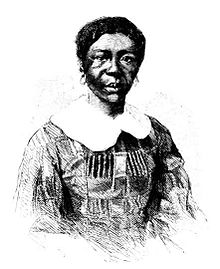Harriet Robinson Scott | |
|---|---|
 Scott in 1857 | |
| Born | Harriet Robinson c. 1820 |
| Died | June 17, 1876 (aged c. 56) |
| Resting place | Greenwood Cemetery |
| Nationality | American |
| Occupation | Laundress |
| Known for | Dred Scott v. Sandford Harriet v. Irene Emerson |
| Spouse | |
| Children | Eliza Scott Lizzie Scott |
Harriet Robinson Scott (c. 1820 – June 17, 1876) was an African American woman who fought for her freedom alongside her husband, Dred Scott, for eleven years. Their legal battle culminated in the infamous United States Supreme Court decision Dred Scott v. Sandford in 1857. On April 6, 1846, attorney Francis B. Murdoch had initiated Harriet v. Irene Emerson in the Circuit Court of St. Louis County, making the Scotts the first and only married couple to file separate freedom suits in tandem.
Born into slavery in Virginia, Harriet Robinson lived briefly in the free state of Pennsylvania before being taken to the Northwest Territory by Indian agent and slaveholder Lawrence Taliaferro. In 1836 or 1837, Harriet married Etheldred, an enslaved man who had been brought to Fort Snelling in present-day Minnesota by Dr. John Emerson, a military surgeon. Their civil wedding ceremony was officiated by justice of the peace Taliaferro, who never actually sold Harriet to Dr. Emerson, since slavery was illegal there.
In 1838, she gave birth to their first child on the steamboat Gipsey as it traveled north on the Mississippi River, in free territory, back to Fort Snelling. In 1840, the Scott family moved to St. Louis in the slave state of Missouri with Irene Emerson, who eventually hired them out to her brother-in-law, Captain Henry Bainbridge, at Jefferson Barracks. After Dr. Emerson's death in 1843, Dred accompanied Captain Bainbridge to Louisiana and Texas, leaving Harriet and their two daughters behind in St. Louis. Harriet was hired out to Adeline Russell, wife of grocery wholesaler Samuel Russell, most likely working as a laundress.
In 1846, Dred Scott returned to St. Louis and tried to purchase his freedom from Mrs. Emerson, who refused. The Scotts then decided to pursue their freedom through the courts. By then, Harriet, a member of the Second African Baptist Church, was aware of the many freedom suits that had been won by enslaved women in St. Louis.
Based on legal precedents set by Winny v. Whitesides in 1824 and Rachel v. Walker in 1836, the Scotts had a strong case and should have won easily. After losing their first trial in 1847 on a technicality, the Scotts were granted a new trial, but were taken into custody by the sheriff on the orders of Mrs. Emerson, to be hired out by him while their cases were still pending. Dred Scott won his second trial in the state court in 1850, briefly winning freedom for his family, but Mrs. Emerson appealed. Lawyers for both sides then agreed to advance only Dred's case with the understanding that the outcome of his case would apply to Harriet's suit as well. Legal historians have argued that this was an error on the part of the Scotts' lawyers, as Harriet's claim to freedom was stronger than that of Dred, and the legal status of children was determined by the status of their mother. As their case progressed through the Missouri Supreme Court, the United States Circuit Court for the District of Missouri, and the Supreme Court of the United States, it became clear that the courts would no longer uphold legal precedent.
On March 6, 1857, the United States Supreme Court led by Chief Justice Roger Taney ruled that the Scotts were not American citizens due to their race, and therefore had no legal rights. It also declared the Northwest Ordinance of 1787 and the Missouri Compromise unconstitutional. Although they failed to win their freedom through the courts, the Scotts were finally emancipated on May 26, 1857, after nationwide media coverage of their high-profile loss caused public embarrassment to Massachusetts Congressman Calvin C. Chaffee, an abolitionist who had married Eliza Irene Sanford Emerson. The Supreme Court ruling ultimately triggered a constitutional crisis, rallied abolitionists, and set the stage for the events leading to the American Civil War, the emancipation of enslaved African Americans, and the Thirteenth, Fourteenth, and Fifteenth Amendments to the U.S. Constitution.
Dred Scott died in 1858, but Harriet survived the Civil War and lived out her days in the company of their two daughters, as well as their grandchildren who had been born into freedom.
The Harriet Scott Memorial Pavilion at Greenwood Cemetery in Hillsdale, Missouri is dedicated to her memory. The Dred and Harriet Scott Statue at the Old Courthouse in St. Louis commemorates where their quest for freedom began.